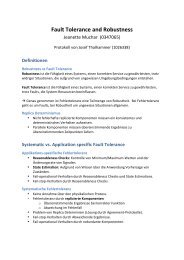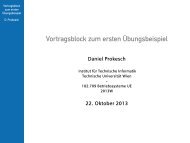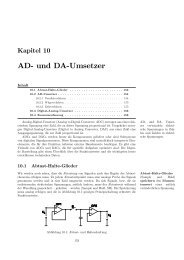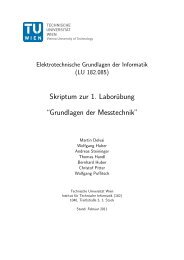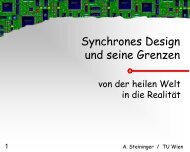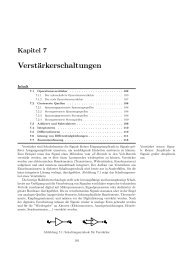Introduction to Microcontrollers
Introduction to Microcontrollers
Introduction to Microcontrollers
Create successful ePaper yourself
Turn your PDF publications into a flip-book with our unique Google optimized e-Paper software.
2.1. PROCESSOR CORE 21<br />
2.1.3 Exercises<br />
addressing mode example result<br />
immediate ADD R1, #5 R1 ← R1 + 5<br />
register ADD R1, R2 R1 ← R1 + R2<br />
direct ADD R1, 100 R1 ← R1 + M[100]<br />
register indirect ADD R1, (R2) R1 ← R1 + M[R2]<br />
post-increment ADD R1, (R2)+ R1 ← R1 + M[R2]<br />
R2 ← R2 + d<br />
pre-decrement ADD R1, −(R2) R2 ← R2 − d<br />
R1 ← R1 + M[R2]<br />
displacement ADD R1, 100(R2) R1 ← R1 + M[100 + R2]<br />
indexed ADD R1, (R2+R3) R1 ← R1 + M[R2+R3]<br />
memory indirect ADD R1, @(R2) R1 ← R1 + M[M[R2]]<br />
Table 2.2: Comparison of addressing modes.<br />
Exercise 2.1.1 What are the advantages of the Harvard architecture in relation <strong>to</strong> the von Neumann<br />
architecture? If you equip a von Neumann machine with a dual-ported RAM (that is a RAM which<br />
allows two concurrent accesses), does this make it a Harvard machine, or is there still something<br />
missing?<br />
Exercise 2.1.2 Why was RISC developed? Why can it be faster <strong>to</strong> do something with several instructions<br />
instead of just one?<br />
Exercise 2.1.3 What are the advantages of general-purpose registers as opposed <strong>to</strong> dedicated registers?<br />
What are their disadvantages?<br />
Exercise 2.1.4 In Section 2.1.2, we compared different address formats. In our example, the accumula<strong>to</strong>r<br />
architecture requires the least instructions <strong>to</strong> execute the task. Does this mean that accumula<strong>to</strong>r<br />
architectures are particularly code-efficient?<br />
Exercise 2.1.5 What are the advantages and drawbacks of a load/s<strong>to</strong>re architecture?<br />
Exercise 2.1.6 Assume that you want <strong>to</strong> access an array consisting of 10 words (a word has 16 bit)<br />
starting at memory address 100. Write an assembler program that iterates through the array (pseudocode).<br />
Compare the addressing modes register indirect, displacement, au<strong>to</strong>-increment, and indexed.<br />
Exercise 2.1.7 Why do negative numbers in an arithmetic shift left (ASL) stay negative as long as<br />
there is no overflow, even though the sign bit is not treated any special? Can you prove that the sign<br />
bit remains set in an ASL as long as there is no overflow? Is it always true that even with an overflow<br />
the result will remain correct (modulo the range)?



